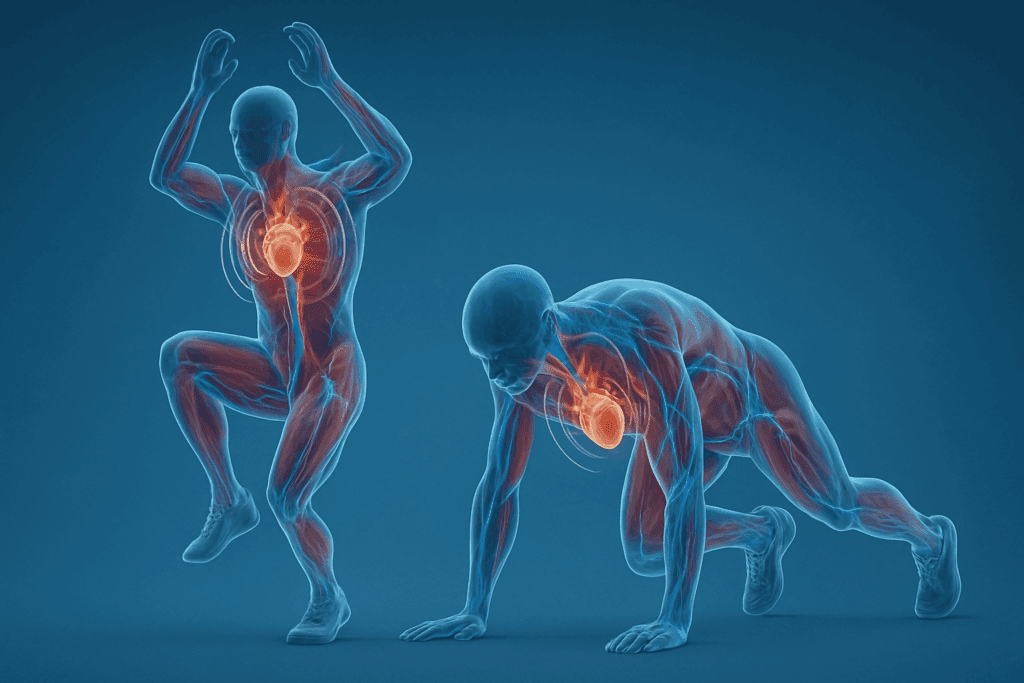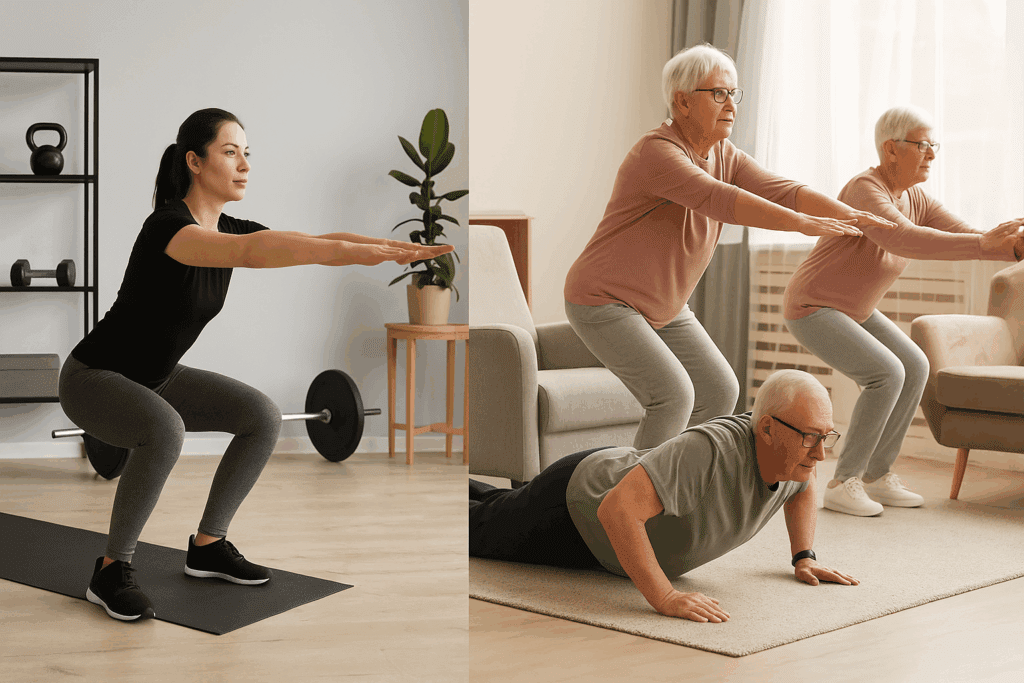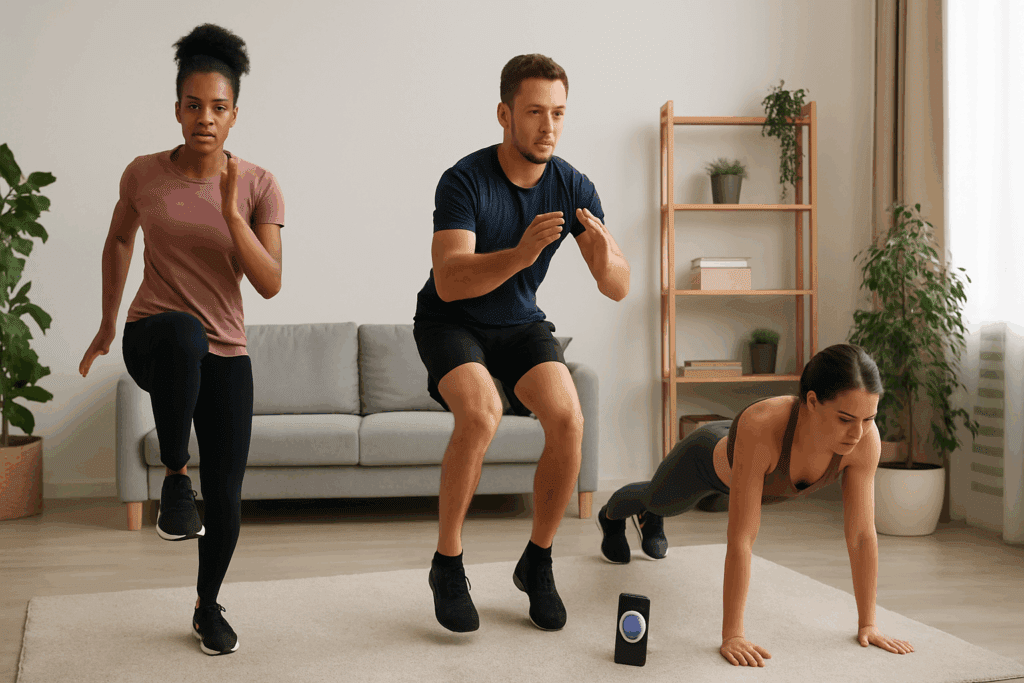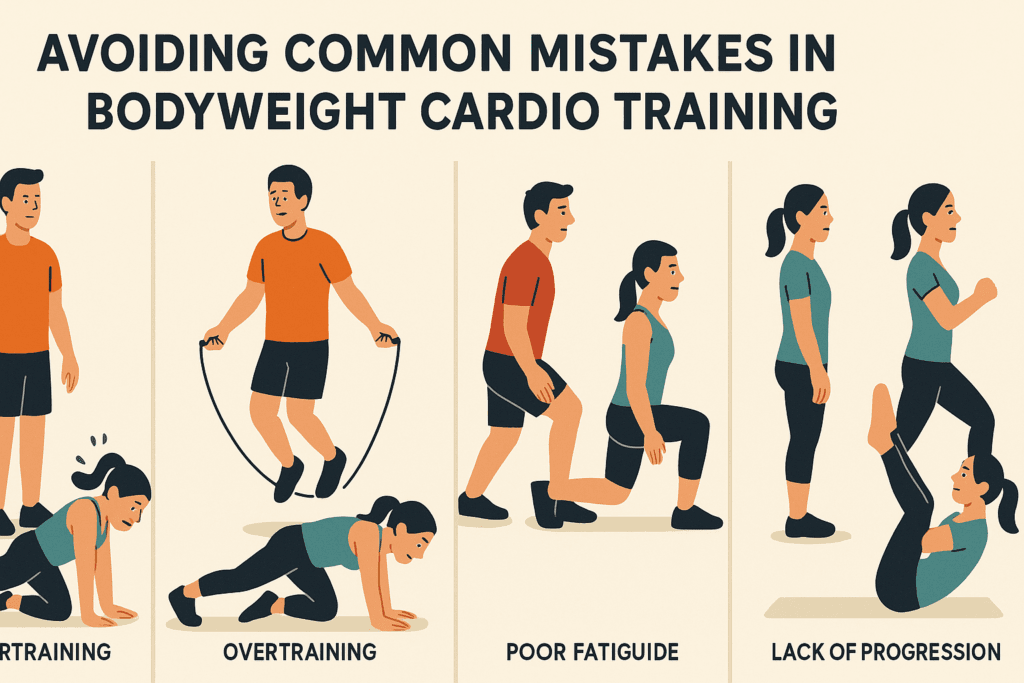Building endurance and enhancing physical performance do not always require gym memberships, expensive equipment, or complex training programs. In fact, many of the most effective methods for improving cardiovascular health, stamina, and athletic output rely solely on the power of your own body. Through consistent application of bodyweight cardio exercises, individuals at any fitness level can increase their endurance naturally, improve their overall health, and elevate their physical performance. This approach, known as cardio and bodyweight training, is not only highly accessible but also grounded in physiological principles that support long-term fitness goals.
You may also like: How to Increase Stamina and Endurance Naturally: Smart Training Tips and Nutrition Habits That Support Cardiovascular Fitness
Bodyweight cardio workouts offer a compelling solution for those seeking functional, efficient training regimens that can be performed virtually anywhere. Especially for individuals navigating demanding schedules, this form of exercise bridges the gap between high-efficiency routines and sustainable physical development. Whether you’re a seasoned athlete or exploring a beginner bodyweight cardio program, these workouts promote cardiovascular resilience, muscular endurance, and metabolic efficiency.

Understanding the Science Behind Bodyweight Cardio Training
At its core, bodyweight cardio combines the principles of aerobic conditioning with the muscular activation inherent in calisthenics. This hybrid approach engages large muscle groups repetitively and rhythmically, stimulating the cardiovascular system in a manner similar to traditional aerobic exercise. Unlike isolated strength training or steady-state cardio alone, bodyweight cardio leverages compound movements that challenge the heart and lungs while simultaneously activating multiple muscle systems.
The physiological adaptations triggered by this training modality include increased stroke volume, improved mitochondrial density, enhanced oxygen uptake, and better capillary exchange. These responses are crucial for anyone aiming to boost aerobic capacity and delay the onset of fatigue. Over time, the consistent application of body weight cardio exercises leads to more efficient energy usage, a stronger heart, and improved lung function.
Research in exercise science supports the efficacy of cardio and bodyweight workouts for improving VO2 max, the maximum rate at which the body can consume oxygen during intense activity. Furthermore, because these workouts often include functional, real-world movements—such as squats, lunges, planks, and burpees—they improve coordination, balance, and agility in addition to endurance.

The Advantages of Body Weight Cardio for Functional Fitness
Functional fitness refers to the development of strength, endurance, and coordination in ways that translate directly to everyday activities. In this context, body weight cardio exercises shine due to their emphasis on full-body movement patterns and dynamic engagement. Unlike machine-based workouts that isolate muscles and limit range of motion, bodyweight cardio promotes joint stability and muscular synergy.
For individuals seeking long-term health and mobility, body weight aerobic exercises build the foundation for resilience and independence. Regular use of these exercises enhances neuromuscular coordination, improves proprioception, and strengthens stabilizer muscles—factors that contribute not just to athletic performance but also to injury prevention and postural integrity.
Additionally, the metabolic demands of calisthenics cardio exercises create a robust training effect without placing excessive strain on joints. This makes bodyweight cardio ideal for people recovering from injuries, older adults aiming to maintain mobility, and those managing chronic conditions like osteoarthritis or hypertension under professional guidance.

Designing a Bodyweight Cardio Routine That Builds Endurance
Creating an effective cardio and bodyweight training program involves more than stringing together high-intensity moves. The goal is to build a structured routine that progressively challenges the cardiovascular and muscular systems while allowing adequate recovery. For those just beginning, a beginner bodyweight cardio regimen might start with 20- to 30-second intervals of exercises like jumping jacks, high knees, mountain climbers, and bodyweight squats, interspersed with short rest periods.
As endurance improves, more complex and demanding movements can be introduced, including plyometric lunges, squat jumps, and push-up to plank transitions. These moves elevate the heart rate quickly and require greater muscular coordination. In more advanced routines, exercises can be performed in circuit formats, combining four to six body weight cardio exercises performed back-to-back with minimal rest. This structure keeps the heart rate elevated, maximizes calorie burn, and stimulates cardiovascular adaptation.
Another key to maximizing results lies in the use of progressive overload—gradually increasing the difficulty of the workout by modifying duration, intensity, or complexity. For example, extending a cardio on the floor session from 15 minutes to 25 minutes or performing more reps within a set time frame are effective ways to introduce new challenges without changing the equipment or environment.

Adapting Bodyweight Cardio to Your Environment and Goals
One of the most attractive features of bodyweight cardio training is its versatility. Unlike many traditional fitness approaches, this style of training requires minimal space and can be performed on nearly any surface. Whether you’re in a hotel room, park, living room, or office break area, body weight cardio can be adapted to fit your space and schedule.
This adaptability also allows workouts to be customized based on individual goals. For those focused on fat loss, incorporating high-intensity intervals of calisthenics cardio exercises into a workout will promote greater calorie expenditure and increase post-exercise oxygen consumption (EPOC), commonly referred to as the afterburn effect. Meanwhile, individuals training for endurance events may benefit more from sustained, moderate-intensity bodyweight routines designed to build aerobic capacity over time.
Importantly, bodyweight cardio does not require advanced athleticism to be effective. With appropriate scaling, movements can be adjusted for beginners, older adults, or those with mobility restrictions. Modifying push-ups by doing them from the knees, or replacing jump squats with air squats, enables full participation while still reaping the cardiovascular and muscular benefits of the workout.

The Role of Consistency and Progression in Cardio and Bodyweight Training
In any endurance-focused fitness regimen, consistency is more important than intensity alone. It is the regular engagement with cardio and bodyweight workouts that leads to physiological change and improved performance. A well-structured routine performed three to five times per week can produce measurable gains in stamina, heart health, and muscular endurance within a matter of weeks.
However, consistent training must be accompanied by thoughtful progression. This means periodically reassessing your routine and adjusting the variables—duration, intensity, rest periods, and movement complexity—to match your evolving fitness level. Without progression, the body adapts to the stimulus and plateaus can occur, limiting continued improvements in endurance.
Incorporating a variety of body weight aerobic exercises within a rotating schedule can help mitigate monotony and reduce the risk of overuse injuries. For example, alternating between high-intensity cardio circuits, core-based cardio on the floor routines, and steady-state sessions ensures a balanced training load and continuous engagement of different muscle groups.
Tracking performance metrics, such as heart rate, time to fatigue, and perceived exertion, can also provide valuable insight into how your cardiovascular system is responding to training. These data points allow for more personalized adjustments and reinforce the value of consistent tracking in long-term progress.
Supporting Mental and Metabolic Health Through Bodyweight Cardio
Beyond the physiological benefits, cardio and bodyweight training also exerts a powerful influence on mental health. The endorphin release that accompanies aerobic activity can help alleviate symptoms of anxiety and depression, improve mood, and enhance cognitive function. Furthermore, the low-barrier nature of bodyweight cardio—requiring no commute or equipment—makes it easier for individuals to establish a consistent habit, which is a critical factor in reaping mental health benefits.
Metabolically, this type of training supports insulin sensitivity, glucose regulation, and lipid profile improvements. It is particularly beneficial for individuals managing or at risk of metabolic syndrome, type 2 diabetes, or cardiovascular disease. When performed regularly, cardio and bodyweight workouts can help lower resting blood pressure, decrease systemic inflammation, and improve overall metabolic function.
Additionally, the mindfulness and body awareness cultivated during bodyweight training sessions contribute to a more holistic approach to wellness. Exercises that emphasize breath control, posture, and movement precision encourage the integration of mind and body, supporting a deeper connection between physical and emotional well-being.

Incorporating Bodyweight Cardio into an Existing Training Program
For athletes and fitness enthusiasts already engaged in structured training programs, integrating bodyweight cardio into existing routines can yield complementary benefits. This type of training can serve as an effective warm-up, active recovery tool, or standalone conditioning session on cross-training days. Because bodyweight cardio is inherently low-impact and customizable, it allows for strategic inclusion without compromising primary training goals.
In sports-specific conditioning, calisthenics cardio exercises can improve foot speed, coordination, and agility—skills relevant across disciplines ranging from basketball and soccer to martial arts and dance. Additionally, athletes seeking to improve work capacity for competition often incorporate high-repetition body weight cardio circuits to build lactate tolerance and improve recovery efficiency between efforts.
Incorporating cardio on the floor routines—such as bear crawls, lateral bounds, and plank variations—can also enhance core strength and stability, leading to better posture and reduced injury risk during more intense lifts or sport-specific drills. These functional advantages make bodyweight cardio a valuable addition even for those who primarily train with weights or sports equipment.
Nutritional Support for Enhanced Endurance and Recovery
While training is fundamental, nutrition plays a vital supporting role in optimizing the benefits of cardio and bodyweight workouts. Adequate intake of macronutrients—particularly complex carbohydrates and lean protein—is essential for fueling performance and accelerating recovery. Carbohydrates provide the primary energy source during high-intensity sessions, while protein supports muscle repair and growth.
Hydration is equally critical, as even mild dehydration can impair aerobic performance and increase perceived exertion. Incorporating electrolytes through food or supplementation may be especially helpful during longer or more intense workouts, particularly in warm environments.
Micronutrients such as B vitamins, magnesium, and iron also contribute significantly to energy metabolism, oxygen transport, and muscular function. Ensuring a nutrient-dense diet rich in vegetables, whole grains, lean proteins, and healthy fats will support both immediate performance and long-term endurance capacity. When combined with consistent training, these nutritional strategies create a synergistic effect that elevates overall results.
Avoiding Common Mistakes in Bodyweight Cardio Training
Although bodyweight cardio exercises offer a safe and accessible training option, certain common mistakes can hinder progress or increase the risk of injury. One of the most frequent issues is neglecting proper warm-up and cool-down routines. Dynamic stretching, mobility drills, and light aerobic activity before the workout prepare the joints and muscles for exertion, while a gradual cool-down aids recovery and prevents dizziness or muscle tightness.
Another pitfall is overtraining—performing high-intensity body weight cardio exercises without adequate rest can lead to burnout, elevated cortisol levels, and diminished results. Balancing effort with recovery is essential, and incorporating rest days or lower-intensity active recovery sessions can support long-term sustainability.
Form degradation due to fatigue is another concern. When technique is compromised, the risk of joint strain and muscular imbalances increases. Focusing on quality over quantity, especially in high-rep circuits, ensures the training effect is both effective and safe. Seeking guidance from fitness professionals or certified trainers can also help refine technique and tailor routines to individual needs.
Frequently Asked Questions: Boost Your Endurance with Bodyweight Cardio
1. Can bodyweight cardio exercises be just as effective as traditional running for endurance training?
Yes, bodyweight cardio exercises can rival traditional running in building endurance when structured strategically. While running provides a repetitive, linear cardiovascular challenge, a well-designed cardio and bodyweight workout engages the heart and lungs with varied full-body movements. This variety helps activate additional muscle groups, which not only supports aerobic capacity but also improves balance and mobility. For individuals seeking joint-friendly alternatives or more dynamic training stimuli, body weight cardio exercises can deliver comparable, if not broader, physiological benefits. Additionally, switching from running to calisthenics cardio exercises can reduce overuse injuries and mental fatigue, making it easier to stay consistent with long-term endurance training.
2. What are some advanced techniques to intensify a beginner bodyweight cardio routine without equipment?
Once you’ve mastered a beginner bodyweight cardio program, intensity can be safely increased through time manipulation, movement layering, and active rest strategies. Increasing the duration of each exercise interval or shortening the rest between rounds challenges your cardiovascular system without adding complexity. Layering movements—such as combining a lunge with a torso twist or adding a jump to a squat—creates compound exercises that boost heart rate and muscular demand. Even during recovery periods, performing low-intensity cardio on the floor, like bird dogs or marching bridges, can maintain aerobic engagement. The key to evolving your bodyweight cardio is progression without compromising form or recovery.
3. How does a cardio and bodyweight training approach benefit people with sedentary jobs?
For professionals with long hours at desks, incorporating a cardio and bodyweight training regimen can counteract the harmful effects of prolonged inactivity. Engaging in short, regular sessions of body weight cardio throughout the day stimulates circulation, prevents muscle stiffness, and promotes better posture. Even brief bursts of body weight aerobic exercises—like five minutes of high knees, standing knee drives, or shadowboxing—can re-energize the body and sharpen mental focus. Over time, this approach improves both stamina and metabolic efficiency, supporting long-term health in environments where movement is limited. Moreover, bodyweight cardio exercises help maintain functional strength, which is often lost when sitting dominates daily life.
4. Is it possible to build muscle with body weight cardio, or is it solely for endurance?
Though cardio and bodyweight workouts are traditionally associated with endurance, they can contribute significantly to muscle development when executed properly. High-repetition movements that involve eccentric loading—like slow push-ups or controlled jump squats—stimulate muscular hypertrophy over time. Alternating between explosive calisthenics cardio exercises and slower, isometric holds encourages both fast- and slow-twitch muscle fiber recruitment. While bodyweight cardio won’t result in the same mass gains as heavy resistance training, it is highly effective for sculpting lean muscle and increasing muscular endurance. Pairing body weight cardio with sufficient protein intake and structured progression can yield aesthetic and functional strength improvements.
5. What’s the best way to stay motivated with a home-based cardio and bodyweight workout plan?
Sustaining motivation with at-home training requires variety, goal setting, and environmental reinforcement. One effective strategy is to rotate focus areas—one day might center on upper-body-centric body weight cardio exercises, while another emphasizes lower body or full-body circuits. Setting specific, measurable goals—such as improving reps per minute or increasing time in motion—adds a sense of achievement and progression. Music, visual timers, or engaging workout apps can simulate the stimulation of a gym environment, making cardio on the floor feel less repetitive. Lastly, involving friends or social accountability—like sharing workout stats online—can add community-driven motivation to your routine.
6. Are there specific breathing techniques that improve performance during bodyweight cardio training?
Breath control is an often-overlooked component of effective cardio and bodyweight training. Utilizing rhythmic breathing aligned with movement—such as exhaling during effort and inhaling during release—can reduce early fatigue and improve oxygen efficiency. For high-intensity bodyweight cardio exercises, adopting nasal breathing during warm-ups and cool-downs can help lower heart rate variability and enhance parasympathetic recovery. Box breathing, a technique involving equal-length inhales, holds, and exhales, is especially effective for calming the nervous system between demanding sets. Consistent practice of intentional breathing not only optimizes performance but also deepens the mind-body connection inherent in calisthenics cardio exercises.
7. How can I incorporate cardio and bodyweight training into a weekly fitness program that already includes resistance lifting?
Integrating body weight cardio into an existing resistance program enhances cardiovascular health without overtaxing recovery systems. It’s best to schedule cardio and bodyweight workouts on alternate days or use them as warm-ups and cooldowns on lifting days. Short bursts of cardio on the floor—like plank jacks or mountain climbers—can also serve as metabolic finishers post-strength training. If you’re aiming for fat loss or improved endurance, consider adding moderate-intensity body weight aerobic exercises during active recovery sessions. This structure allows you to reap the conditioning benefits of cardio without interfering with strength gains or overall training balance.
8. Can calisthenics cardio exercises help older adults maintain independence and mobility?
Absolutely, calisthenics cardio exercises are particularly effective for older adults due to their emphasis on functional movement and joint-friendly intensity. Exercises like chair squats, step jacks, and seated punches can be modified to fit any fitness level while still providing the aerobic stimulus needed for heart health. Regular engagement in these low-impact bodyweight cardio routines improves balance, coordination, and confidence in daily tasks like walking, bending, or lifting. Furthermore, the rhythmic nature of body weight cardio promotes cognitive stimulation, supporting mental clarity and motor learning in aging populations. When guided properly, these exercises offer a safe and empowering path to maintaining long-term independence.
9. What recovery practices support frequent bodyweight cardio sessions without risking burnout?
To sustain frequent cardio and bodyweight training without overtraining, recovery must be as intentional as the workouts themselves. Prioritizing hydration and quality sleep sets the foundation for tissue repair and energy restoration. Incorporating mobility drills and light cardio on the floor—such as cat-cow stretches or bird-dogs—can promote active recovery and reduce delayed onset muscle soreness. Nutrition also plays a pivotal role; consuming a blend of protein and carbohydrates post-workout helps replenish glycogen and repair muscle fibers. Finally, weekly self-assessments of mood, energy, and performance help detect signs of fatigue early, allowing for adjustments that support longevity in your bodyweight cardio practice.
10. What future trends are emerging in the world of body weight cardio and digital fitness?
The fusion of cardio and bodyweight workouts with technology is reshaping how people train at home and on the go. Emerging platforms now offer AI-guided coaching that customizes bodyweight cardio exercises in real time, adjusting for heart rate, fatigue, and movement accuracy. Virtual reality (VR) fitness programs are beginning to include full-body body weight aerobic exercises, creating immersive training environments that are both engaging and effective. Additionally, there’s growing interest in combining biometric tracking—like heart rate variability and oxygen saturation—with calisthenics cardio exercises to fine-tune workout intensity for individual needs. As wearable tech becomes more advanced, personalized cardio and bodyweight training will likely become even more efficient, adaptive, and data-informed for users at every level.
Conclusion: Embrace the Power of Bodyweight Cardio to Transform Your Endurance and Performance
The path to improved stamina and performance doesn’t have to be paved with expensive machines, complex regimens, or gym memberships. With the strategic use of bodyweight cardio exercises, anyone—from beginners to seasoned athletes—can cultivate endurance, enhance cardiovascular health, and support long-term fitness goals. The natural integration of calisthenics cardio exercises into your routine offers a dynamic, engaging, and medically sound approach to performance enhancement and functional fitness.
Whether you’re diving into a beginner bodyweight cardio program or optimizing your current training with cardio on the floor sessions, this accessible modality empowers you to push past plateaus, support metabolic health, and stay active for life. Through consistent application, thoughtful progression, and holistic support including proper nutrition and recovery, cardio and bodyweight workouts become a powerful cornerstone of a well-rounded endurance training program.
By making body weight cardio a consistent part of your fitness journey, you not only build physical resilience but also invest in a lifestyle rooted in strength, mobility, and vitality—an investment that pays lifelong dividends.
Was this article helpful? Don’t let it stop with you. Share it right now with someone who needs to see it—whether it’s a friend, a colleague, or your whole network. And if staying ahead on this topic matters to you, subscribe to this publication for the most up-to-date information. You’ll get the latest insights delivered straight to you—no searching, no missing out.

